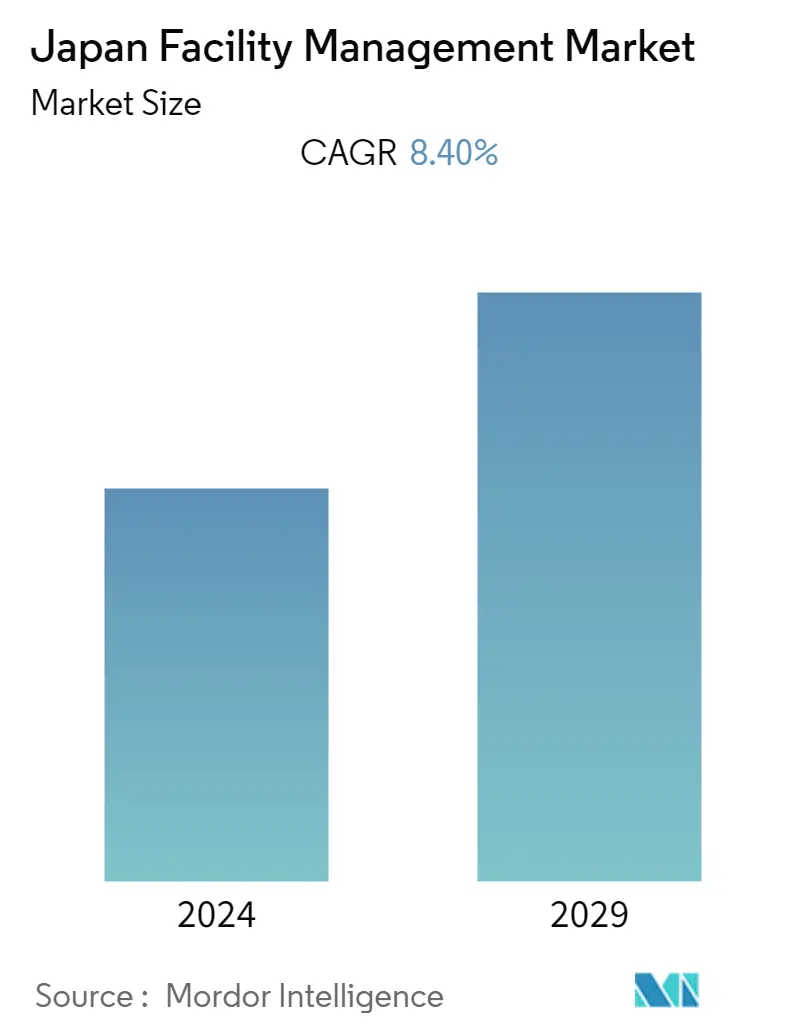Market Size of Japan Facility Management Industry

| Study Period | 2019 - 2029 |
| Base Year For Estimation | 2023 |
| Forecast Data Period | 2024 - 2029 |
| Historical Data Period | 2019 - 2022 |
| CAGR | 8.40 % |
| Market Concentration | Low |
Major Players
*Disclaimer: Major Players sorted in no particular order |
Japan Facility Management Market Analysis
The Japanese facility management market is expected to grow at a CAGR of 8.40% during the forecast period, 2022-2027. The growing emphasis on outsourcing of non-core operations and growth in the real estate sector is expected to drive the Japanese market for facility management services. Along with this, the government regulation on safety measures and environmental concerns to follow green practices is expected to drive the market.
The increased spending on the infrastructural aspect in Japan can be cited as one of the major drivers of the growth of the FM market. Moreover, the increasing focus on optimization processes and energy efficiency improvements are the main driving forces for the development of the facility management market.
Along with this, real estate, manufacturing, retail, and the public sector are a few industry verticals that have witnessed high infrastructural growth in the country. These verticals mentioned above constitute the primary end users of facility management solutions, owing to the growing need for integrating data from operational facilities into other business applications.
The region's facility management industry operates with integrated contracts provided by significant vendors across continents and borders, and small local players focus on single contracts and single-service solutions. However, there are increasing opportunities to leverage facility management and corporate real estate in new ways, given the dynamics occurring across the region.
Facility management (FM) includes management methods and techniques for building management, infrastructure management for an organization, and overall harmonization of the work environment in an organization. This system standardizes services and streamlines processes for an organization. Across the last decade, several service vendors operating in the region have been focused on expanding their presence to leverage the increasing demand for facility management, especially with the recent trend favoring the outsourcing of non-core operations. Further, Japan has been witnessing increased opportunities to leverage facility management and corporate real estate in innovative ways, given the dynamics across the country.
Japan has adopted several efforts to attract investment and visitors to aid the country's recovery from the impacts of the Covid-19 epidemic. The International Monetary Fund upped the country's economic growth forecast for 2022 to 2.4%, citing Japan's reaction to the COVID-19 epidemic.
Japan Facility Management Industry Segmentation
Facility management (FM) is a profession that incorporates many disciplines to ensure functionality, safety, comfort, and efficiency of the built environment by integrating people, process, place, and technology. FMs contribute to the business's bottom line through its responsibility for often maintaining an organization's most significant and most valuable assets, such as property, equipment, buildings, and other environments that house personnel, productivity, inventory, and other elements of the operation.
Facility management services involve the management of building upkeep, utilities, maintenance operations, waste services, security, etc. These services are further divided into hard facility management services and soft facility management services spheres.
Both in-house facility management and outsourced FM services are considered in the scope. The integrated facility management service (IFM) market, along with single and bundled services, is included in the outsourced FM services segment.
The Japan Facility Management Market is segmented by Type of Facility Management (In-house Facility Management and Outsourced Facility Management (Single FM, Bundled FM, Integrated FM)), by Offering type (Hard FM, Soft FM), and by End-user (Commercial, Institutional, Public/Infrastructure, Industrial).
| By Fcaility Management | |||||
| Inhouse Facility Management | |||||
|
| By Offering | |
| Hard FM | |
| Soft FM |
| By End User | |
| Commercial | |
| Institutional | |
| Public/Infrastructure | |
| Industrial | |
| Other End Users |
Japan Facility Management Market Size Summary
The Japanese facility management market is poised for significant growth, driven by the increasing trend of outsourcing non-core operations and the expansion of the real estate sector. This growth is further supported by government regulations emphasizing safety and environmental sustainability, which encourage the adoption of green practices. The market is also benefiting from heightened infrastructure spending and a focus on optimizing processes and enhancing energy efficiency. Key industry verticals such as real estate, manufacturing, retail, and the public sector are primary end users of facility management solutions, necessitating the integration of operational data with other business applications. The market landscape is characterized by a mix of integrated contracts from major international vendors and single-service solutions from local players, with opportunities for innovative applications of facility management and corporate real estate.
The shift from single-service models to integrated facilities management (IFM) is a notable trend, offering streamlined operations and improved efficiency. This transition is facilitated by advancements in technology, which are transforming work environments into smart buildings. The commercial segment, particularly influenced by rapid infrastructural development and the rise of the IT sector, plays a significant role in the market's expansion. The recovery from COVID-19 impacts and investments in major events like the Tokyo Olympics have further stimulated the construction and commercial sectors. The market is highly competitive and fragmented, with numerous players engaging in mergers, acquisitions, and partnerships to navigate current challenges. Notable developments include strategic expansions and the introduction of advanced tools for property evaluation and marketing, underscoring the dynamic nature of the Japanese facility management market.
Japan Facility Management Market Size - Table of Contents
-
1. MARKET INSIGHTS
-
1.1 Market Overview
-
1.2 Industry Attractiveness - Porter's Five Forces Analysis
-
1.2.1 Bargaining Power Of Suppliers
-
1.2.2 Bargaining Power Of Buyers
-
1.2.3 Threat Of New Entrants
-
1.2.4 Threat Of Substitutes
-
1.2.5 Intensity Of Competitive Rivalry
-
-
1.3 Impact Of Covid-19 On The Market
-
-
2. MARKET SEGMENTATION
-
2.1 By Fcaility Management
-
2.1.1 Inhouse Facility Management
-
2.1.2 Outsourced Facility Management
-
2.1.2.1 Single FM
-
2.1.2.2 Bundled FM
-
2.1.2.3 Integrated FM
-
-
-
2.2 By Offering
-
2.2.1 Hard FM
-
2.2.2 Soft FM
-
-
2.3 By End User
-
2.3.1 Commercial
-
2.3.2 Institutional
-
2.3.3 Public/Infrastructure
-
2.3.4 Industrial
-
2.3.5 Other End Users
-
-
Japan Facility Management Market Size FAQs
What is the current Japan Facility Management Market size?
The Japan Facility Management Market is projected to register a CAGR of 8.40% during the forecast period (2024-2029)
Who are the key players in Japan Facility Management Market?
Globeship Sodexo, JLL Japan, Compass Group Inc., CBRE Japan and Cushman & Wakefield are the major companies operating in the Japan Facility Management Market.

